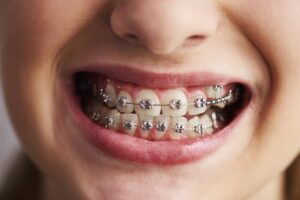
Orthodontic Myths Debunked: What Science Says
Did you know that nearly 80% of people believe common myths about orthodontic treatment? From the pain of braces to the age limit for treatment, misconceptions abound. In this post, we’ll uncover the truth behind these prevalent myths and separate fact from fiction. Armed with science-backed insights, you’ll gain a clear understanding of what to expect when seeking orthodontic care. So, let’s dive in and debunk these misconceptions once and for all.
Orthodontic Treatment for Children: Facts Over Fiction
Early Intervention Benefits
Early orthodontic care isn’t just about aesthetics; it can prevent more severe issues later on. Studies have shown that addressing orthodontic problems in children at a young age can help avoid more complicated treatments in the future. For example, correcting bite alignment early on can prevent jaw pain and difficulty chewing as they grow older.
Braces for children are not only about straightening teeth but also promoting good oral health. When left untreated, misaligned teeth or jaw problems can lead to difficulties in speaking, eating, and maintaining proper oral hygiene. By addressing these issues early through orthodontic treatment, children can avoid potential dental complications and enjoy better overall well-being.
Tailored Treatment for Children
Children’s orthodontic treatment is customized to their unique needs. Each patient receives personalized care based on their specific dental structure and any existing orthodontic issues. This tailored approach ensures that the treatment addresses individual concerns effectively, leading to better outcomes for young patients.
Debunking Common Misconceptions About Braces
Braces Fact: No Permanent Damage to Teeth
Some people believe that braces cause permanent damage to teeth, but this is a common misconception. In reality, when orthodontic treatment is carried out by a qualified professional and the patient follows proper care instructions, there should be no long-term damage to the teeth. The pressure applied by braces is carefully controlled and helps move the teeth into their correct positions over time.
Braces are designed to gradually shift the position of the teeth in a controlled manner, allowing them to align properly. As a result, any discomfort or soreness experienced during orthodontic treatment is usually temporary and manageable with over-the-counter pain relief medication or wax provided by your orthodontist.
Modern Braces: Less Noticeable and More Comfortable
Contrary to popular belief, modern braces are less noticeable than they used to be. With advancements in technology, traditional metal braces now come in smaller sizes and sleeker designs. There are less conspicuous options such as clear ceramic braces or lingual braces that are placed on the back of the teeth.
Furthermore, modern materials used in braces have made them more comfortable for wearers. For example, nickel-titanium wires exert lighter forces on the teeth while still maintaining effective tooth movement. This means that individuals undergoing orthodontic treatment can experience less discomfort compared to older versions of braces.
Adult Orthodontics: Separating Myths from Reality
Age Should Not Be a Barrier to Seeking Orthodontic Care
Many people believe that orthodontic treatment is only effective during adolescence, but myths like these are far from the truth. In fact, it’s never too late for adults to benefit from orthodontic treatment. Research conducted by dental schools and professional groups has shown that adult orthodontics can significantly improve oral health and overall well-being. For instance, correcting misaligned teeth can make it easier to maintain good oral hygiene, reducing the risk of gum disease and tooth decay.
Moreover, seeking orthodontic care as an adult should not be discouraged due to age-related misconceptions. The reality is that adult orthodontics can address various concerns such as overcrowding, spacing issues, or bite problems effectively. By debunking these myths, individuals of all ages can understand that they have the opportunity to enhance their smile and oral health through orthodontic treatment.
The Science Behind Adult Orthodontics Debunks Common Misconceptions
The science behind adult orthodontics refutes common misconceptions surrounding age limitations for treatment effectiveness. Scientific studies have demonstrated how braces or aligners can successfully correct misalignments in adults’ teeth without any negative impact on their well-being. This scientific evidence emphasizes the importance of dispelling prevalent myths about adult orthodontics.
For example, research published in reputable dental journals has highlighted the positive outcomes of adult orthodontic interventions in improving both dental function and aesthetics. These findings serve as concrete proof that age should not deter anyone from considering or pursuing beneficial orthodontic treatments tailored for adults.
The Impact of Wisdom Teeth on Orthodontic Health
Alignment Effect
Wisdom teeth can indeed impact the alignment of existing teeth. When wisdom teeth grow in, they can exert pressure on nearby molars, causing them to shift position. This shifting can lead to overcrowding or misalignment of the other teeth.
Some individuals may experience no issues with their wisdom teeth, while others might notice a significant impact on their dental health due to these additional molars. It’s essential for individuals to have regular dental check-ups and X-rays to monitor the growth and position of their wisdom teeth.
Removal Consideration
Removing wisdom teeth is often considered as a preventive measure against potential future orthodontic issues. By removing these extra molars before they cause problems, individuals can avoid complications such as crowding or misalignment that may require orthodontic treatment later in life.
However, not all individuals need their wisdom teeth removed solely for orthodontic reasons. Each case is unique, and it’s important for individuals to consult with an orthodontist or dentist who can assess whether the presence of wisdom teeth could lead to future dental health concerns.
- Regular dental check-ups are crucial for monitoring the impact of wisdom teeth.
- Removing wisdom teeth preventatively can mitigate potential future orthodontic issues.
- Consultation with a professional is key in determining whether removal is necessary based on individual circumstances.
Addressing Myths Around Orthodontic Treatment and Speech
No Lasting Impact
Orthodontic treatment does not necessarily cause speech problems. Any adjustments in speech during orthodontic treatment are temporary and normal. For example, when braces are first fitted, the tongue may take some time to adjust to the new presence in the mouth. This can lead to temporary changes in speech patterns such as lisping or minor difficulties with certain sounds.
Braces should not hinder speech clarity if they are properly fitted. Once the tongue adapts to the presence of braces, many people find that any initial speech adjustments revert back to normal. It’s important for individuals undergoing orthodontic treatment to communicate openly with their orthodontist about any concerns regarding speech so that necessary adjustments can be made.
The Importance of Proper Fit
Properly fitted braces play a crucial role in ensuring that they do not interfere with an individual’s ability to speak clearly. In cases where there is difficulty speaking due to braces, it could be a sign that the braces need adjustment or repair. Therefore, it is essential for individuals receiving orthodontic treatment to address any discomfort or difficulty speaking with their orthodontist promptly.
Longevity of Orthodontic Results: Expectations vs Reality
The Role of Retainers
Retainers are crucial in maintaining orthodontic results. Even after the braces come off, teeth can move over time. Lifelong changes in tooth position are natural, but retainers help preserve alignment. For example, a fixed retainer is a thin wire bonded to the back of the front teeth to prevent them from shifting.
Regular use of retainers is essential for preventing relapse and ensuring that your teeth remain straight and aligned as intended by orthodontic treatment.
Oral Hygiene and Dental Check-ups
Good oral hygiene practices and regular dental check-ups also play a significant role in ensuring the longevity of orthodontic results. Brushing twice daily with fluoride toothpaste, flossing regularly, and using an antiseptic mouthwash can help maintain overall oral health.
Attending routine dental appointments allows your dentist to monitor any changes in your oral health or potential shifts in your teeth’ alignment. Early detection of issues can lead to prompt intervention, preserving the outcomes achieved through orthodontic treatment.
Daily Life with Braces: Demystifying the Experience
Eating with Braces
Adapting to eating with braces is essential for a comfortable experience. While some adjustments may be needed, eating various foods is still possible. For instance, opting for softer fruits and vegetables can make chewing more manageable. Cutting food into smaller pieces can also help prevent damage to the braces.
Maintaining a balanced diet during orthodontic treatment is crucial for overall health. Despite the need for some dietary modifications, individuals can still enjoy a wide variety of foods by making simple changes in their eating habits.
Oral Hygiene Routines
With braces, oral hygiene routines require slight adaptations but remain highly effective. Using specialized tools like interdental brushes and floss threaders helps reach areas that traditional brushing might miss. It’s important to maintain diligent oral care to prevent plaque buildup and potential dental issues during orthodontic treatment.
Regular visits to the dentist or orthodontist are also vital for professional cleanings and check-ups throughout the course of wearing braces. By following these adjusted oral hygiene practices diligently, individuals can ensure that their teeth stay healthy while undergoing orthodontic treatment.
Sports and Physical Activities
Engaging in sports and physical activities is still very much possible with proper mouth protection while wearing braces. Mouthguards specifically designed for athletes with braces offer adequate protection against impacts during sports activities such as basketball, soccer, or martial arts.
The Preventive Benefits of Orthodontic Procedures
Health Benefits
Orthodontic treatment offers health benefits beyond just improving the appearance of one’s smile. By correcting bite issues, it can alleviate jaw pain and discomfort. When teeth are properly aligned, they are easier to clean, reducing the risk of decay and gum disease.
Crooked or misaligned teeth can lead to various dental problems in the future. For example, overlapping teeth can create hard-to-reach areas where plaque and food particles accumulate, increasing the likelihood of cavities and gum inflammation. When there is a misalignment in the bite, it can cause excessive wear on certain teeth due to uneven pressure distribution during chewing.
Properly aligned teeth not only contribute to better oral hygiene but also play a crucial role in overall health. With improved oral hygiene comes a reduced risk of developing systemic conditions such as heart disease or diabetes that have been linked to poor dental health.
Insurance Coverage for Adult Orthodontics
Varying Coverage
Insurance coverage for adult orthodontics is available through some dental insurance plans. However, it’s essential to note that the extent of this coverage can vary significantly among different insurance providers and their plans. For instance, while one plan may offer comprehensive coverage for orthodontic treatments, another might only provide partial benefits or none at all.
Understanding the specific details of your insurance benefits is crucial in making adult orthodontic treatment more accessible. By familiarizing yourself with the coverage offered by your insurance plan, you can better navigate the financial aspects of undergoing orthodontic procedures as an adult.
For example:
- One dental insurance plan may cover a certain percentage of the total cost of braces or aligners, while another plan might have a fixed dollar amount limit.
- Some plans may require pre-authorization or impose waiting periods before covering orthodontic treatments.
Accessible Treatment
Being knowledgeable about your insurance benefits enables you to make informed decisions regarding when and how to pursue adult orthodontic care. With a clear understanding of what your insurance covers, you can take proactive steps towards seeking treatment without being caught off guard by unexpected costs.
Final Remarks
So there you have it! We’ve busted some common myths and shed light on the reality of orthodontic treatment for both children and adults. Remember, knowledge is power, and now armed with these facts, you can make informed decisions about orthodontic care. Don’t let misconceptions hold you back from achieving a healthy, beautiful smile.
If you’re considering orthodontic treatment or know someone who is, share this article to spread awareness and help others separate fact from fiction. Your journey to a confident smile starts with understanding the truth behind orthodontic myths. Keep smiling and stay informed!
Bruno Orthodontics offers Invisalign, braces, and other orthodontic treatment for adults, teens, and children in an award-winning office in Chevy Chase. Dr. Jill Bruno is a Diamond+ Provider for Invisalign, putting her in the top 1% of Invisalign doctors. Convenient online scheduling and virtual consults are available for new and current patients.



